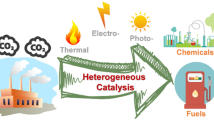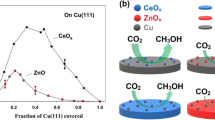Abstract
Binary Cu/ZnO catalysts with varying molar ratios (90/10 through 10/90) were studied under methanol synthesis conditions at 493 K and at atmospheric pressure. The methanol synthesis activity of the catalysts was correlated to their specific Cu surface area (N2O reactive frontal chromatography, N2O RFC) after reduction in 2 vol% H2 at 513 K. Activity data were supplemented with a detailed analysis of the microstructure, i.e., crystallite size and strain of the reduced Cu and the ZnO phases after reduction using X-ray diffraction line profile analysis. The estimated copper surface area based on a spherical shape of the copper crystallites is in good agreement with data determined by N2O RFC. A positive correlation of the turnover frequency for methanol production with the observed microstrain of copper in the Cu/ZnO system was found. The results indicate a mutual structural interaction of both components (copper and zinc oxide) in the sense that strained copper particles are stabilized by the unstrained state of the zinc oxide microcrystallites. The observed structural deformation of ZnO in samples with higher Cu loading can originate, for instance, from epitaxial bonding of the oxide lattice to the copper metal, insufficient reduction or residual carbonate due to incomplete thermal decomposition during reduction. Additional EXAFS measurements at the Cu K and the Zn K edge show that about 5% ZnO are dissolved in the CuO matrix of the calcined precursors. Furthermore, it is shown that the microstructural changes (e.g., size and strain) of copper can be traced back to the phase composition of the corresponding hydroxycarbonate precursors.
Similar content being viewed by others
References
K. Klier, Adv. Catal. 31 (1982) 243.
B.S. Rasmussen,P.E.H. Nielsen,J. Villadsen andJ.B. Hansen, in: Preparation of Catalysts IV, eds. B. Delmon,P. Grange,P.A. Jacobs andG. Poncelet (Elsevier, Amsterdam, 1987) p. 785.
K. Klier, Appl. Surf. Sci. 19 (1984) 267.
J. Nakamura,I. Nakamura,T. Uchijima,T. Wantanabe andT. Fujitani, Stud. Surf. Sci. Catal. 101 (1996) 1389.
G.C. Chinchen andK.C. Waugh, Appl. Catal. 25 (1986) 101.
R. Burch,S.E. Golunski andM.S. Spencer, J. Chem. Soc. Faraday Trans. 86 (1990) 2683.
M.S. Spencer, Topics Catal. 8 (1999) 259.
N.-Y. Topsøe andH. Topsøe, Topics Catal. 8 (1999) 267.
C.V. Ovesen,B.S. Clausen,J. Schiøtz,P. Stoltze,H. Topsøe andJ.K. Nørskov, J. Catal. 168 (1997) 133.
B.S. Clausen,J. Schiøtz,L. Gråbæk,C.V. Ovesen,K.W. Jacobsen,J.K. Nørskov andH. Topsøe, Topics Catal. 1 (1994) 367.
N.-Y. Topsøe andH. Topsøe, J. Mol. Catal. A 141 (1999) 95.
R.A. Hadden,P.J. Lambert andC. Ranson, Appl. Catal. 122 (1995) L1.
J.-L. Li andT. Inui, Appl. Catal. A 137 (1996) 105.
J.W. Couves,J.M. Thomas,D. Waller,R.H. Jones,A.J. Dent,G.E. Derbshire andG.N. Greaves, Nature 354 (1991) 465.
B. Bems, M.M. Günter, D. Herein, M. Schur and R. Schlögl, in preparation.
O. Hinrichsen,T. Genger andM. Muhler, Chem.-Ing.-Tech. 72 (2000) 94.
G.C. Chinchen,C.M. Hay,H.D. Vanderwell andK.C. Waugh, J. Catal. 103 (1987) 79.
J.R. Anderson andK.C. Pratt, Introduction to Characterization and Testing of Catalysts (Academic Press, New York, 1985).
J.I. Langford, J. Appl. Crystallogr. 11 (1978) 10.
M.M. Günter, T. Ressler, B. Bems and R. Schlögl, in preparation.
G.K. Williamson andW.H. Hall, Acta Metall. Mater. 1 (1953) 22.
D.R. Lide andH.P.R. Frederikse, eds., The CRC Handbook of Chemistry and Physics: a Ready-Reference Book of Chemical and Physical Data, 80th Ed. (CRC, Boca Raton, FL, 1999).
H.E. Swanson andE. Tatge, Natl. Bur. Stand. (US) Circ. 539, I (1953) 15.
R.W. Joyner, Catal. Lett. 6 (1990) 151; R. Burch, S.E. Golunski and M.S. Spencer, Catal. Lett. 6 (1990) 155, and references therein.
E. Kampshoff,E. Hahn andK. Kern, Phys. Rev. Lett. 73 (1994) 704.
M. Mavrikis,B. Hammer andJ.K. Nørskov, Phys. Rev. Lett. 81 (1998) 2819.
T. Fujitani andJ. Nakamura, Catal. Lett. 56 (1998) 119.
S.S. Rao andT.R. Anantharaman, Curr. Sci. 32 (1963) 262.
C. Delorme, Bull. Soc. Franc. Mineral. 81 (1958) 19.
A.C. Roberts, Powder Diffraction 1 (1986) 1.
Author information
Authors and Affiliations
Rights and permissions
About this article
Cite this article
Günter, M., Ressler, T., Bems, B. et al. Implication of the microstructure of binary Cu/ZnO catalysts for their catalytic activity in methanol synthesis. Catalysis Letters 71, 37–44 (2001). https://doi.org/10.1023/A:1016696022840
Issue Date:
DOI: https://doi.org/10.1023/A:1016696022840




